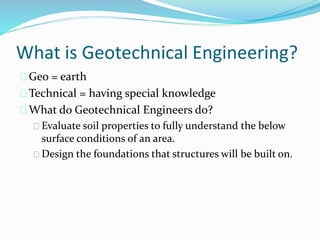About Geotheta
About Geotheta
Blog Article
The smart Trick of Geotheta That Nobody is Discussing
Table of ContentsGeotheta - TruthsHow Geotheta can Save You Time, Stress, and Money.Some Known Facts About Geotheta.The Best Guide To Geotheta
They collaborate with civil engineers, structural engineers, architects, and various other specialists to incorporate geotechnical factors to consider right into the total job style and building and construction procedure. This needs efficient team effort, coordination, and communication to guarantee that the geotechnical facets align with the project purposes and meet regulatory requirements.Mining & Materials Engineering: Concepts of boring, penetration rates, and elements affecting the choice of exploration approach. Features of dynamites, firing systems and blast patterns. Blowing up techniques in surface area and underground workings. Unique blasting strategies at excavation perimeters. Resonance and noise control. Mechanical and constant methods to fragmentation, including longwall shearing and fullface boring.
Modelling of piece and fragment dimension circulations; comminution as a transfer function. Comminution technology: squashing, grinding, size classification. Integrated evaluation of fragmentation and comminution operations. Supplied by: Mining & Products Engineering.
About Geotheta
Bachelor's degree programs in civil, geotechnical, geological, and environmental design normally last 4 years and consist of general education and learning training courses in English, social scientific research, and the humanities, in addition to programs in sophisticated maths, architectural geology, and fluid mineralogy. (https://geotheta-46958753.hubspotpagebuilder.com/blog/unlocking-the-future-with-top-notch-geotechnical-engineers-at-geotheta)
Geotechnical design involves the assessment of the dirt and rock conditions at a particular website, and their ramifications for the growth of that site. As many frameworks rely on the ground for support, it lacks shock that an in-depth understanding of the ground problems, and the viability of foundation systems, are essential to the long-term security and efficiency of the structure or structure.
Specialising in the examination of geological formations and ground behavior, geotechnical designers carry out clinical examinations and testing to recognize the effect these geological formations might have on the design and building and construction of structure, civil and infrastructure projects. This experience is important for the style and building of structures, roadways, passages, dams, bridges, and water supply and sewer system.
The geotechnical team at Douglas Allies routinely consult with engineers, layout engineers, developers, and builders to make recommendations on design and advancement propositions to make sure that the developed frameworks are suitably designed for the ground problems. The layout of footing systems needs to take into consideration the weight of the framework, the capacity of the ground to sustain that weight with each other with activity resistances and reliable building and construction.
Some Ideas on Geotheta You Need To Know
This job is substantially simplified by the use our Douglas Map geospatial system that makes this information readily accessible in an easy to visit the website utilize web internet browser interface. A geotechnical designer will certainly direct the boring of boreholes and test pits to gather dirt and various other samples, and also assess surface area features and ground exposures to develop a geotechnical design of the subsurface conditions.
Depending on the job kind and ground conditions experienced, laboratory testing may amongst other things assess stamina, compressibility, reactivity and/or leaks in the structure of dirt and rock samples. Hereafter information is gathered and looked at, the results are made use of for a geotechnical model of the website, which is typically provided as areas across the site.

A geotechnical investigation naturally can just assess the ground problems at the areas drilled or dug deep into. All-natural variants in soil and rock problems can take place throughout a site and in between examination areas. It is for that reason great technique that the geotechnical engineer be preserved throughout building of the job to give on-site verification that the ground conditions encountered are regular with the expectations and suggestions provided in the geotechnical investigation record.
The Greatest Guide To Geotheta
Geotechnical engineers utilize their thorough understanding of dirt and rock to analyze risk and solve troubles on varied infrastructure projectsGeotechnical design is a specialist branch of civil design which looks at the behavior of planet products and the application of dirt and rock technicians. Geotechnical Engineers. As a geotechnical designer, you will certainly examine the physical, mechanical and chemical properties of soil and rock in order to create foundations, preserving frameworks and earthworks
Geotechnical design is carefully linked to and overlaps with, both design geology and ground design - https://forums.hostsearch.com/member.php?265240-geotheta. It's feasible to be experts in geotechnics or benefit a geotechnical firm but be called a design geologist or a ground engineer. As a geotechnical designer, you'll need to: develop and maintain connections with clients and various other specialists involved in the website, throughout each projectmaintain safety and security criteria on site bear in mind expense ramifications when you make recommendationsstudy geological maps and aerial pictures from a variety of resources and from different time periodsexamine building plans to see how possible they are based on your understanding of the siteinvestigate risks or geological dangers for the sitesearch for ecologically sensitive functions, such as landfill beginning to establish accurate and interpretive ground modelsplan area investigationsdrill and analyse examples of bedrock, soil, groundwater and additional materials monitor other specialists on sitesolve technological issues as they occur, such as unexpected structures at drill sitesmonitor problems during and after building to make certain structures are secure in the brief and long termadding data collected on site to your preliminary researchcreating geotechnical estimations, illustrations, and two or three-dimensional computer system designs interpreting the datamaking suggestions regarding the recommended use the website

Report this page